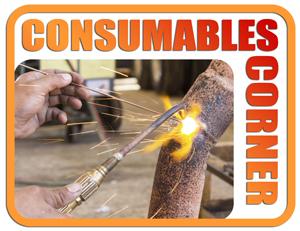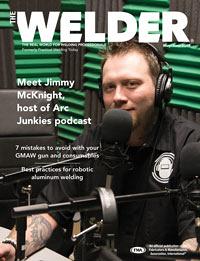Independent welding consumables professional
- FMA
- The Fabricator
- FABTECH
- Canadian Metalworking
Categories
- Additive Manufacturing
- Aluminum Welding
- Arc Welding
- Assembly and Joining
- Automation and Robotics
- Bending and Forming
- Consumables
- Cutting and Weld Prep
- Electric Vehicles
- En Español
- Finishing
- Hydroforming
- Laser Cutting
- Laser Welding
- Machining
- Manufacturing Software
- Materials Handling
- Metals/Materials
- Oxyfuel Cutting
- Plasma Cutting
- Power Tools
- Punching and Other Holemaking
- Roll Forming
- Safety
- Sawing
- Shearing
- Shop Management
- Testing and Measuring
- Tube and Pipe Fabrication
- Tube and Pipe Production
- Waterjet Cutting
Industry Directory
Webcasts
Podcasts
FAB 40
Advertise
Subscribe
Account Login
Search
Consumables Corner: Preventing cracks when welding high-strength steel
- By Nino Mascalco, Rob Koltz, and Steve Sigler
- May 16, 2018
- Article
- Consumables
Q: We manufacture a plow-type mechanism that is made from A514 (T1) steel, with hinges that are made from lower-strength steel such as A572 or A36. On a particular machine, the design calls for the plow to be made from 3/4-in.-thick AR400 and the hinges to be made from 3/4-in.-thick A514. We're using GMAW with a 90 percent argon/10 percent carbon dioxide shielding gas, and an ER120 filler metal. We've been experiencing a lot of cracking, either in the weld metal or base material. Any suggestions on how we can fix this?
A: Let's take a look at the materials you mentioned and review the specifics for each one as well as the strategies for welding them.
A514 and AR400 are high-strength, low-alloy (HSLA) steels that get their properties from the quench and tempering (Q&T) process. These types of high-strength materials have very low amounts of alloy, such as nickel, chromium, and molybdenum, that enhance the mechanical properties. The key difference between these two is that A514 is highly versatile and can be used in many applications, whereas AR400 is abrasion- and impact-resistant and should not be used in structural load-bearing applications.
A514 has a tensile strength range of 110 to 130 KSI and a Brinell hardness number (BHN) range of 235 to 293, depending on the grade you use. AR400 has tensile strength between 170 and 190 KSI and a BHN minimum of 400, hence the name.
Using an ER120 filler metal and 90 percent argon/10 percent CO2 shielding gas with the GMAW process is perfectly acceptable. It's actually beneficial because of the low-hydrogen characteristics of this process and wire type.
In most situations you match your filler metal to the lowest-strength base material that is being joined, which in this case is the A514. However, the AR400 is not meant for load-bearing applications, so technically it is the weakest link. Additionally, you stated that this is a plowing mechanism so the materials are more than likely chosen for their impact and abrasion resistance and not their overall strength.
If you can verify this with the design engineer and material supplier, you may be able to weld it with a lower-strength filler metal such as an ER70 or ER80 classification. These alloys have a low alloy content, and the weld metal will be less susceptible to the formation of crack-sensitive metallurgical phases (that is, martensite). From a technique standpoint, use stringer beads and if necessary some light weld bead peening to help reduce residual weld stresses.
Two pieces of information are necessary in identifying the cause of your cracking issues. First, what types of cracks are you getting? Second, are you preheating the joints before welding? If so, to what temperature?
Under-bead cracks and cracks that run transverse to the welding direction are typically caused by hydrogen entrapment. For this to happen, the microstructure must be susceptible to hydrogen embrittlement and a hydrogen source. Failing to preheat and slow-cool the welded parts properly can cause martensite to form in the weld or heat-affected zone (HAZ) of the base material.
Martensite is a brittle microstructure that is highly susceptible to hydrogen entrapment. Since hydrogen is the smallest of all elements, it can move through the microstructure freely where it accumulates near grain boundaries, and that creates extreme intergranular pressure. This internal pressure, along with a low-ductility microstructure, can lead to hydrogen-induced cracking and a potentially catastrophic failure.
Preheating and slow cooling are the most important steps in making this welding application successful. Since both base materials are Q&T, pay close attention to preheat and maximum interpass temperature. For the thicknesses given, the AR400 should have a minimum preheat of 250 degrees F and the A514 a minimum of 125 degrees F. The maximum interpass temperature for both materials is 400 degrees F. If you exceed these values, more than likely some annealing will occur, which results in lower strength properties. Last, keep the welding heat input under 55 kilojoules per inch.
About the Authors


Rob Koltz
Application Engineer
411 S. Ebenezer Rd.
Florence, 29501
636-485-2253
Steve Sigler
Application Engineer
411 S. Ebenezer Rd.
Florence, South Carolina 29501
636-485-2253
About the Publication
Related Companies
subscribe now

The Welder, formerly known as Practical Welding Today, is a showcase of the real people who make the products we use and work with every day. This magazine has served the welding community in North America well for more than 20 years.
start your free subscription- Stay connected from anywhere

Easily access valuable industry resources now with full access to the digital edition of The Fabricator.

Easily access valuable industry resources now with full access to the digital edition of The Welder.

Easily access valuable industry resources now with full access to the digital edition of The Tube and Pipe Journal.
- Podcasting
- Podcast:
- The Fabricator Podcast
- Published:
- 04/16/2024
- Running Time:
- 63:29
In this episode of The Fabricator Podcast, Caleb Chamberlain, co-founder and CEO of OSH Cut, discusses his company’s...
- Trending Articles
Sheffield Forgemasters makes global leap in welding technology

ESAB unveils Texas facility renovation

Engine-driven welding machines include integrated air compressors

How welders can stay safe during grinding

The impact of sine and square waves in aluminum AC welding, Part I

- Industry Events
16th Annual Safety Conference
- April 30 - May 1, 2024
- Elgin,
Pipe and Tube Conference
- May 21 - 22, 2024
- Omaha, NE
World-Class Roll Forming Workshop
- June 5 - 6, 2024
- Louisville, KY
Advanced Laser Application Workshop
- June 25 - 27, 2024
- Novi, MI



























